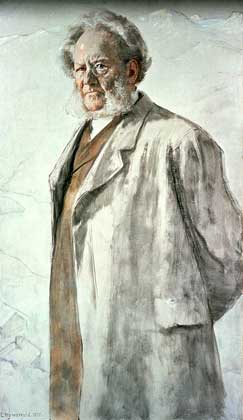The directory «Plots»
Ibsen Henrik Johan
(1828–1906)

Norwegian dramatist and poet. His early years were lonely and miserable. Distressed by the consequences of his family’s financial ruin and on his own at sixteen, he first was apprenticed to an apothecary. Not long after this he began writing poetry, and in 1850 he published his first play, Catilina, a tragedy in verse. In 1851 he began an extended apprenticeship in the theater, first as stage manager and playwright with the National Stage in Bergen and in 1857 as theater director for the Norwegian Theater in Oslo. His early plays for the most part went unrecognized or were greeted with opposition and critical hostility. As a man far in advance of his times, Ibsen was condemned for unveiling truths which society preferred to keep hidden. In 1864, dissatisfied with the backwardness of Norway, he went to Italy. He wrote the bulk of his drama there and in Germany. His career can be divided into three periods. The first phase, that of poetic dramas, dealt primarily with historical themes, folklore, and romantic pageantry. His name was established with the publication of Love’s Comedy (1862). However, it was in 1866 that he reached prominent stature as a dramatist, when he published the first of his major works, Brand, the tragedy of an idealist. Peer Gynt, another poetic drama and Ibsen’s least understood work, appeared the following year. In this play Ibsen recounted the adventures of an egocentric but imaginative opportunist. With The League of Youth (1869) and Pillars of Society (1877), he began his second dramatic phase, that of the realistic social plays which are his best known. Ibsen rebelled against society’s conventions through which the perpetuation of empty traditions restricts all intellectual, artistic, and spiritual growth. He was perhaps most successful in depicting the 19th-century woman, whose inner nature was in strong conflict with the role she was called on to perform. These dramas include A Doll’s House (1879), Ghosts (1881), Rosmersholm (1886), and Hedda Gabler (1890). Other notable plays, An Enemy of the People (1882) and The Wild Duck (1884), examine the effects of true and false idealism. Although nearly all Ibsen’s plays contain symbolic elements, it was in his final works that the emphasis on symbolism became very strong. The chief plays of this group are The Master Builder (1892), Little Eyolf (1894), John Gabriel Borkman (1896), and When We Dead Awaken (1900). All have a firmly knit structure beneath the symbols; all blend an introspective realism with folk poetry. No playwright has exerted greater influence on 20th-century drama. His plays—there are many good English translations—are continually revived in the United States and Europe.
Bulgaria, 1956, Henrik Ibsen
Gambia, 2001, Henrik Ibsen
German Federal Republic, 1976, Louise Dummont as Hedda Gabler
Monaco, 1993, Grieg, Music and Trolls from «Peer Gynt»
Norway, 1928, Henrik Ibsen
Norway, 1928, Henrik Ibsen
Norway, 1928, Henrik Ibsen
Norway, 1928, Henrik Ibsen
Norway, 1978, Peer Gunt
Norway, 1978, Henrik Ibsen
Norway, 1999, Scene from «Peer Gynt»
Rumania, 1956, Henrik Ibsen
Rumania, 2006, Henrik Ibsen
USSR, 1956, Henrik Ibsen